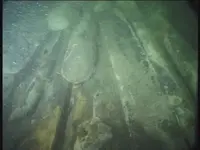You are using an out of date browser. It may not display this or other websites correctly.
You should upgrade or use an alternative browser.
You should upgrade or use an alternative browser.
Low-alpha / antiquity lead
- Thread starter chengiskhan
- Start date
AUVnav
Sr. Member
- Joined
- Mar 10, 2012
- Messages
- 455
- Reaction score
- 86
- Golden Thread
- 0
- Primary Interest:
- All Treasure Hunting
Yes, Lead is from depleted or decayed Uranium..this may help. While there is primordal lead, the most common is from radioactive decay.
When you look at a Lead sample from a spectrograph, it will give the amounts of the different isotopes.
Isotopes of lead - Wikipedia, the free encyclopedia
Note from the table, you get down to Pb204 before it is stable, and others have common names such as Pb206 Radium G, or Pb207 Actinium D....
When you look at a Lead sample from a spectrograph, it will give the amounts of the different isotopes.
Isotopes of lead - Wikipedia, the free encyclopedia
Note from the table, you get down to Pb204 before it is stable, and others have common names such as Pb206 Radium G, or Pb207 Actinium D....
Last edited:
VOC
Sr. Member
- Joined
- Apr 11, 2006
- Messages
- 484
- Reaction score
- 191
- Golden Thread
- 0
- Location
- Atlantic Ocean
- Primary Interest:
- All Treasure Hunting
I Learn something everyday, and that will do for today's !
Yes, Lead is from depleted or decayed Uranium..this may help. While there is primordal lead, the most common is from radioactive decay.
When you look at a Lead sample from a spectrograph, it will give the amounts of the different isotopes.
Isotopes of lead - Wikipedia, the free encyclopedia
Note from the table, you get down to Pb204 before it is stable, and others have common names such as Pb206 Radium G, or Pb207 Actinium D....
AUVnav
Sr. Member
- Joined
- Mar 10, 2012
- Messages
- 455
- Reaction score
- 86
- Golden Thread
- 0
- Primary Interest:
- All Treasure Hunting
Kinda makes on think twice about that 800 pounds of lead in the garage doesnt it?

It may be prudent to carry a rad badge...I have one on my drivers license (because I carry that everywhere) and one on my dive helmet. Although the only time I have been stopped is when the dogs at the airport pick up the cordex on the dive suit...
It may be prudent to carry a rad badge...I have one on my drivers license (because I carry that everywhere) and one on my dive helmet. Although the only time I have been stopped is when the dogs at the airport pick up the cordex on the dive suit...
Last edited:
Salvor6
Silver Member
- Joined
- Feb 5, 2005
- Messages
- 3,762
- Reaction score
- 2,186
- Golden Thread
- 0
- Location
- Port Richey, Florida
- Detector(s) used
- Aquapulse, J.W. Fisher Proton 3, Pulse Star II, Detector Pro Headhunter, AK-47
- Primary Interest:
- Shipwrecks
Lead is NOT depleted uranium. I worked at the Y-12 weapons plant in Oak Ridge TN. We made all kinds of parts out of depleted uranium (D-38). It machines completely different than lead. When machining D-38 it must be kept submerged in coolant because it starts sparking. Lead is found in nature as lead oxide. Depleted uranium is much harder than lead.
AUVnav
Sr. Member
- Joined
- Mar 10, 2012
- Messages
- 455
- Reaction score
- 86
- Golden Thread
- 0
- Primary Interest:
- All Treasure Hunting
Well, I mixed the depleted and decayed with a bit of license....
D-38 is technically "reactor depleted", relying on processed material, and reducing the amount of U238, which has a much shorter half life than other Uranium isotopes. This process occurs in nature, and in mining activity.
When you hear about radioactive dating of material, it is calibrated with the fixed ratio of Pb204 to the primordial amounts of the other lead isotopes and used as the baseline to estimate the extra amounts of radiogenic lead present in rocks as a result of decay from uranium and thorium.
In reality, primordal lead, ie 4.5 Billion years old, is not that common, with as you state, most lead in nature is an isotope, or oxide as you will, which has decayed from Polonium, Thallium, and Uranium.
I would note that DU, with the half life of U238, has spent the alpha radiation, but still emits overall radiation levels of around 60% of natural occurring Uranium.
Most commercial aircraft use DU as counterweight in the ends of the wings...should an aircraft crash, and burn...you have a serious emergency that very few, if any people, realize...
In ammunition, one of the factors was density, being almost 2 times as dense as lead, and on impact, the round would ignite. For small caliber ammunition, it was 'self-sharpening" meaning that it would not deform as lead, but would fragment, into sharp pieces.
Additional notes: I looked up reactor core. The core is made up of scintered uranium oxide, compressed with graphite and carbon. This is why DU from reactors is so dense and brittle.
D-38 is technically "reactor depleted", relying on processed material, and reducing the amount of U238, which has a much shorter half life than other Uranium isotopes. This process occurs in nature, and in mining activity.
When you hear about radioactive dating of material, it is calibrated with the fixed ratio of Pb204 to the primordial amounts of the other lead isotopes and used as the baseline to estimate the extra amounts of radiogenic lead present in rocks as a result of decay from uranium and thorium.
In reality, primordal lead, ie 4.5 Billion years old, is not that common, with as you state, most lead in nature is an isotope, or oxide as you will, which has decayed from Polonium, Thallium, and Uranium.
I would note that DU, with the half life of U238, has spent the alpha radiation, but still emits overall radiation levels of around 60% of natural occurring Uranium.
Most commercial aircraft use DU as counterweight in the ends of the wings...should an aircraft crash, and burn...you have a serious emergency that very few, if any people, realize...
In ammunition, one of the factors was density, being almost 2 times as dense as lead, and on impact, the round would ignite. For small caliber ammunition, it was 'self-sharpening" meaning that it would not deform as lead, but would fragment, into sharp pieces.
Additional notes: I looked up reactor core. The core is made up of scintered uranium oxide, compressed with graphite and carbon. This is why DU from reactors is so dense and brittle.
Last edited:
guys can anyone point me in the direction of a current buyer for LAL? and give me a real value on this stuff? i've been interested in recovering some for years but with all the research i've done i never was able to make contact with a buyer. alot of the info out there is old so i'm curious as of july 2012 what the real deal is on this stuff. any help would be greatly appreciated pm or ncsurfer83@aol.com
maipenrai
Bronze Member
- Joined
- Nov 11, 2010
- Messages
- 1,145
- Reaction score
- 242
- Golden Thread
- 0
- Location
- Thailand/Europe/California
- Detector(s) used
- Excalibur 2 1000
- Primary Interest:
- All Treasure Hunting
Seems like a lot of people with lead, if they can be connected to buyers, that would be nice.
Redzieak49@gmail.com
Tenderfoot
- Joined
- Aug 11, 2016
- Messages
- 7
- Reaction score
- 1
- Golden Thread
- 0
- Location
- Ontong java atoll
- Detector(s) used
- N/A
- Primary Interest:
- All Treasure Hunting
Hey guys, the discovery of the old shipwrecks have alot of irons ingot and bars. the shipwrecks sunk since 1765 and 1874. These shipwrecks have leads but they also tampered so I believed the ship was burned.
seekerGH
Hero Member
- Joined
- Jan 25, 2016
- Messages
- 887
- Reaction score
- 570
- Golden Thread
- 0
- Primary Interest:
- All Treasure Hunting
Here is an article on the details of low-alpha lead. Considering its usage may help one find a buyer.
The back-end process: Step 2 ? Wafer bumping Low-alpha lead considerations | Solid State Technology
Manufacturer of low-alpha soldier, and appear to be in FLA: Low Alpha Material solder
Manufacturers and Suppliers of ALPHA-Lo® Low Alpha Materials For Over 16 Years 177 US Hwy 1: No. 306 Tequesta, FL 33469-2737 Email: jerry@puretechnologies.com
Phone. +1-404-964-3791 Fax: +1-877-738-8263 International Fax: +1-973-273-2132
The back-end process: Step 2 ? Wafer bumping Low-alpha lead considerations | Solid State Technology
Manufacturer of low-alpha soldier, and appear to be in FLA: Low Alpha Material solder
Manufacturers and Suppliers of ALPHA-Lo® Low Alpha Materials For Over 16 Years 177 US Hwy 1: No. 306 Tequesta, FL 33469-2737 Email: jerry@puretechnologies.com
Phone. +1-404-964-3791 Fax: +1-877-738-8263 International Fax: +1-973-273-2132
Last edited:
Travisboyd
Tenderfoot
- Joined
- Jun 1, 2019
- Messages
- 1
- Reaction score
- 0
- Golden Thread
- 0
- Primary Interest:
- All Treasure Hunting
Hi All,
I am looking for antiquity or "low-alpha" lead.
This lead would need to be from the early 1700's or even older.
Most likely place to find it would be on ancient
I have some it was an casing or an insulator for some kind of underwater wire that's been there since probably the late 1800s but before that nuclear bombs and all that in the Fallout I probably have a ton right now
igoreseven
Tenderfoot
- Joined
- Aug 3, 2019
- Messages
- 1
- Reaction score
- 0
- Golden Thread
- 0
- Location
- San Pedro Calif.
- Primary Interest:
- Beach & Shallow Water Hunting
I have a keel from "HIGHLAND LIGHTS", along with the documentation of the vessel which states the 34,000 lb. keel was poured in the year 1931 on the East coast of USA and she was built for the Trans Atlantic Race in 1932. Very possibly low alpha lead. I'm searching for the correct procedure and people to verify through sci. analysis. I'm not even sure what the test is called but spectrum analysis wont provide the answers I need. Measure the rate of decay of Alpha particle radiation?
Please let me know if you are interested. Thanks.
Please let me know if you are interested. Thanks.
xaos
Bronze Member
- Joined
- Jul 3, 2018
- Messages
- 1,062
- Reaction score
- 2,302
- Golden Thread
- 0
- Primary Interest:
- All Treasure Hunting
You need lead that either started out low alpha, or is a few hundred years old...1931 is a bit of a stretch...but who knows what the source may have been.
You are correct, a typical mass spec or xrf is not going to give you the alpha load, simply the %Pb...if it shows %Po levels, you can be pretty certain is is not low alpha...
I suggest sending a sample to a supplier...(like the one listed in post #52
Low Alpha Lead
You are correct, a typical mass spec or xrf is not going to give you the alpha load, simply the %Pb...if it shows %Po levels, you can be pretty certain is is not low alpha...
I suggest sending a sample to a supplier...(like the one listed in post #52
Low Alpha Lead
Last edited:
Magoopeter
Sr. Member
- Joined
- Jan 21, 2016
- Messages
- 367
- Reaction score
- 899
- Golden Thread
- 0
- Detector(s) used
- underwater
- Primary Interest:
- Shipwrecks
The best lead is said to be from Cornwall, 1700, s that area of the world had the lowest levels of natural radiation, so I’m told, the lead was exported, to holland and used for roofs, the first low alpha lead I believe was from old houses in holland pre 1786.
The VOC wrecks are said have the best lead as it was imported to Holland then shipped to their colonies.
I recovered lead for IBM in 2002, it was used to shield electronics on satellites so as the radio frequency produced from all the components did not interfere with the really sensitive components, I was also told as computers get smaller that low alpha lead would be needed for the same reason?



Also a few gold coins, i think the lead was worth more than silver then, but not now
The VOC wrecks are said have the best lead as it was imported to Holland then shipped to their colonies.
I recovered lead for IBM in 2002, it was used to shield electronics on satellites so as the radio frequency produced from all the components did not interfere with the really sensitive components, I was also told as computers get smaller that low alpha lead would be needed for the same reason?



Also a few gold coins, i think the lead was worth more than silver then, but not now
whydahdiver
Full Member
- Joined
- Apr 2, 2012
- Messages
- 186
- Reaction score
- 239
- Golden Thread
- 0
- Primary Interest:
- All Treasure Hunting
On the Whydah, 1717 we found rolled up lead sheets 6 feet long. They used it for many purposes like scupper liners and touch hole aprons and hull repairs, they now sit in the project laboratory on Cape Cod.
WD
WD
Magoopeter
Sr. Member
- Joined
- Jan 21, 2016
- Messages
- 367
- Reaction score
- 899
- Golden Thread
- 0
- Detector(s) used
- underwater
- Primary Interest:
- Shipwrecks
https://www.amazon.com/Between-Tides-Shipwrecks-Irish-Coast/dp/1445653338?tag=treasurenet01-20
There is a wreck in this book 350 ton of low alpha lead, the author is the best shipwreck researcher in Ireland and his info is spot on, enjoy.
There is a wreck in this book 350 ton of low alpha lead, the author is the best shipwreck researcher in Ireland and his info is spot on, enjoy.
Similar threads
Users who are viewing this thread
Total: 1 (members: 0, guests: 1)


